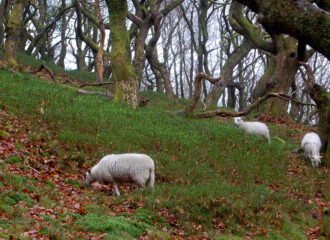Although shaped by timber felling and/or intensive sheep-grazing in the recent past, these woods are often important for the biodiversity they support: most notably for their bryophyte, lichen and woodland bird communities. They are also aesthetically pleasing and popular with both the general public and those with a deeper appreciation of natural history. The most common forms of modified sessile oak wood in Wales are described below
Modified sessile oak states

Modified state 1 – Sheep-grazed ‘Atlantic’ sessile oak woods
These woods are temperate rain forests that have been modified by sheep-grazing, resulting in an almost total lack of successful oak saplings in the understorey and an increasingly homogeneous age structure. However, the humidity of these woods and the light from canopy gaps, glades and rides create ideal conditions to support diverse and internationally important…
Read more Modified state 1 – Sheep-grazed ‘Atlantic’ sessile oak woods

Modified state 2 – Single-aged sessile oak woods
Many of the accessible sessile oak woods were virtually clear-felled for timber during World Wars I and II, resulting in predominantly single-aged stands less than 100 years old. This does not, however, diminish their importance as sources of biodiversity, as some of these single-aged stands in humid situations support diverse and internationally important bryophyte and…

Modified state 3 – Sessile oak ‘bluebell’ woods
These aesthetically pleasing sessile oak woods tend to occur in less oceanic locations with lower levels of humidity. Many of the woods are single-aged as a result of clear-felling for timber during the last century and they are typically sheep-grazed with low levels of regeneration. The spring groundflora is often dominated by bluebells (Hyacynthoides non-scriptus)…

Modified state 4 – Overgrazed mature ‘continental’ sessile oak wood
Excluding sheep from sessile oak woods is critical for enabling successful sapling recruitment under canopy gaps, but is easier said than done. Despite being recently fenced, small numbers of sheep were still able to access this wood and, despite an abundance of seedlings, there were no successful saplings in the understorey.
Read more Modified state 4 – Overgrazed mature ‘continental’ sessile oak wood

